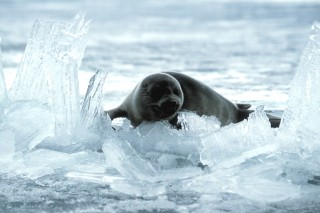Seal Teeth Offer Glimpse Into the Environmental Past of Russia's Lake Baikal

Victor Kantor courtesy of Wellesley College A nerpa seal pictured in Siberia's Lake Baikal
March 21 marks World Water Day—and a fitting time to consider one of the most unique mammals in the Earth’s waters.
The nerpa, also known as the Baikal seal, is the only seal that lives exclusively in fresh water. This earless seal can be found in just one place, Russia’s Lake Baikal, where it is at the top of the food web. And now, Wellesley scientists have found that the teeth of this particular seal may hold the strongest evidence of the effects of decades of environmental pollution, nuclear testing, and climate change on Lake Baikal—the deepest, oldest, and most bio-diverse lake in the world.
“The Baikal seal teeth are a chemical record of the lake,” said Marianne Moore, Wellesley Professor of Biological Sciences. By analyzing the chemical composition of hundreds of seal teeth, Professor Moore and her co-researchers, post-doctoral fellow Ted Ozersky and Wellesley student Xiu Ying (Annie) Deng ‘15, are working to reconstruct the Baikal seal’s diet and contaminant burdens over the last 80 years. The teeth were collected from ice harvested in the area by fellow scientists in Russia.
Baikal seals can live up to 40 and 50 years, and much like the rings of a tree trunk, the layers of dentine within their teeth can be studied and linked to environmental patterns and changes over a period of time. Moore, Ozersky, and Deng are looking for evidence of toxic metals such as uranium, mercury, cadmium, and zinc inside the teeth samples, which date back to the period before industrialization in the region.
Why not just measure these toxic elements in the water? Professor Moore explained that these metals show up at extremely low levels in the water. The teeth of the nerpa are actually better indicators due to biomagnification, the process by which the concentration of a substance increases with each level of the food chain. Because the Baikal seal is at the top of its food web, their teeth hold the best clues into the lake’s environmental past.
“Ultimately, the goal of our project is to study contamination levels in Lake Baikal as reflected by the seals, and to tie these patterns to changes in the watershed, such as the introduction of mining in the area, an increase in coal burning, and other environmental events,” said Dr. Ozersky.
Still early in the project, the Wellesley researchers have already made a surprising discovery: levels of some toxic metals such as uranium were higher in the mid 1970’s than in seals today. This suggests improving environmental conditions in the region. High levels of uranium in the mid 1970’s may represent the legacy of atmospheric nuclear testing that ended in 1980 in Asia.
Media Contact
More Information:
http://www.wellesley.eduAll latest news from the category: Ecology, The Environment and Conservation
This complex theme deals primarily with interactions between organisms and the environmental factors that impact them, but to a greater extent between individual inanimate environmental factors.
innovations-report offers informative reports and articles on topics such as climate protection, landscape conservation, ecological systems, wildlife and nature parks and ecosystem efficiency and balance.
Newest articles

Targeted use of enfortumab vedotin for the treatment of advanced urothelial carcinoma
New study identifies NECTIN4 amplification as a promising biomarker – Under the leadership of PD Dr. Niklas Klümper, Assistant Physician at the Department of Urology at the University Hospital Bonn…

A novel universal light-based technique
…to control valley polarization in bulk materials. An international team of researchers reports in Nature a new method that achieves valley polarization in centrosymmetric bulk materials in a non-material-specific way…

How evolution has optimised the magnetic sensor in birds
The magnetic sense of migratory birds is probably based on the protein cryptochrome 4, and a genetic study has now provided further support for this theory. A team of researchers…





















